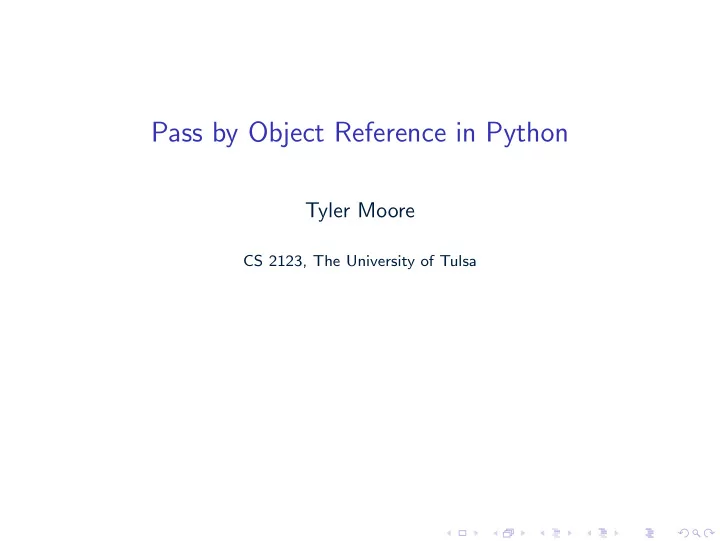

Pass by Object Reference in Python Tyler Moore CS 2123, The University of Tulsa
Variables in Python Better thought of as names or identifiers attached to an object. A nice explanation: http://python.net/~goodger/projects/pycon/2007/ idiomatic/handout.html#other-languages-have-variables 2 / 8
Key distinction: mutable vs. immutable objects Immutable: objects whose value cannot change Tuples (makes sense) 1 Booleans (surprise?) 2 Numbers (surprise?) 3 Strings (surprise?) 4 Mutable: objects whose value can change Dictionaries 1 Lists 2 User-defined objects (unless defined as immutable) 3 This distinction matters because it explains seemingly contradictory behavior 3 / 8
Variable assignment in action >>> #variables are really names ... c = 4 >>> d = c >>> c+=1 >>> c 5 >>> d #d does not change because numbers are immutable 4 >>> #lists are mutable ... a = [1,4,2] >>> b = a #so this assigns the name b to the object attached to name a >>> a.append(3) >>> a [1, 4, 2, 3] >>> b #b still points to the same object, its contents have just changed. [1, 4, 2, 3] 4 / 8
Pass by object reference In Python, variables are not passed by reference or by value Instead, the name (aka object reference) is passed If the underlying object is mutable, then modifications to the object will persist If the underlying object is immutable, then changes to the variable do not persist For more info, see: https://jeffknupp.com/blog/2012/11/13/ is-python-callbyvalue-or-callbyreference-neither/ 5 / 8
Im/mutablility and function calls >>> #let’s try this in a function ... def increment(n): #n is a name assigned to the function argument when called ... #because numbers are immutable, the following ... #reassigns n to the number represented by n+1 ... n+=1 ... return n ... >>> a = 3 >>> increment(a) 4 >>> #a does not change ... a 3 6 / 8
Im/mutablility and function calls >>> def sortfun(s): ... s.sort() ... return s ... >>> def sortfun2(s): ... l = list(s) ... l.sort() ... return l ... >>> a = [1,4,2] >>> sortfun(a) [1, 2, 4] >>> a [1, 2, 4] >>> b = [3,9,1] >>> sortfun2(b) [1, 3, 9] >>> b [3, 9, 1] 7 / 8
Im/mutablility and function calls def selection_sort(s): """ Input: list s to be sorted Output: sorted list """ for i in range(len(s)): #don’t name min since reserved word minidx=i for j in range(i+1,len(s)): if s[j]<s[minidx]: minidx=j s[i],s[minidx]=s[minidx],s[i] return s >>> b [3, 9, 1] >>> selection_sort(b) [1, 3, 9] >>> b [1, 3, 9] 8 / 8
Recommend
More recommend